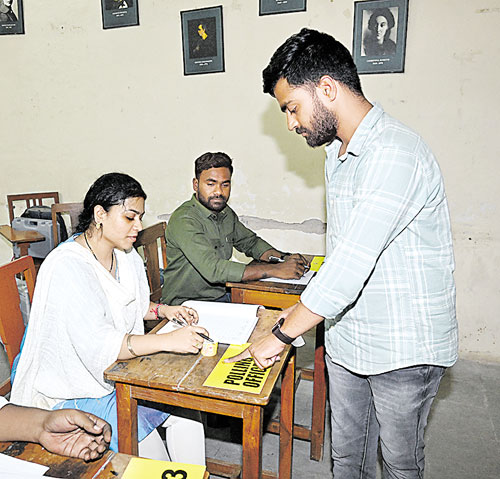Hyderabad: In a democracy, the voter is the real decider. Every voter needs to exercise his precious right to vote if the country and the state are to prosper.
The voter should not doubt the vote to elect the leader who will continue as his representative for five years. It is not enough to stand in a queue at the polling centre and press a lever on the EVM after entering the centre. It is necessary to make sure that the vote he has cast has gone to the candidate he wants to cast or not.

For this, the Election Commission of India (ECI) is implementing an accountability system in polling. Voting Card (VV Pat) is displayed so that the voter can confirm whether his vote has been cast or not.

However, during the recent polling in Karnataka, a voter's post on social media 'X' expressing doubts about the voting process went viral. The Central Election Commission has denied it.

The Election Commission clarified that the voting process is very transparent. In this context, 'ETV Bharat' asked the Chief Electoral Officer of Telangana Vikasraj to show a demo to make voters aware of the election process.
As per his orders, the officials demonstrated the mock polling system at the election training center set up in Nizam College, Hyderabad. He explained how EVMs work and how voters can check their vote.

Steps to follow while voting:
- After entering the polling centre with the voter's ticket and identity card, the voter should first go to the polling officer-1. The officer will check the details of the voter against the list of voters in his possession. The voter's name and serial number in the list will be read aloud
- From there the voter should go to Polling Officer 2. The officer checks the details of the ticket in his possession and takes his signature. If the voter is illiterate then fingerprint will be taken. An ink mark is placed on the index finger of the left hand
- For both the Assembly and Lok Sabha seats, the Election Officers give two different colored slips to the voters. Based on them they exercise the right to vote in two ballot units
- After that, the voter should go to the Polling Officer-3. The officer examines the ticket held by the voter. He presses the lever in the control unit and releases the vote. (Before the release of the vote, the green LED light on the left side of the control unit lights up. After the release of the vote, the red light on the right side lights up. This can be observed by the voter)
NOTE: In case of simultaneous elections to the Lok Sabha and Legislative Assemblies, two control units will be established.

After that, the voter should go to the ballot unit. There is a green LED light on the top of this unit. One has to press the lever next to the name of the candidate for whom he/she decides to vote on the ballot paper pasted on the ballot unit.

When the lever is pressed, the red light will light up in the arrow next to it. A beep will sound. The green light on the ballot unit will turn off. A ticket appears on the ballot unit in the nearby VVPAT machine.

In it, the party symbol and the name of the candidate will be visible. This ticket will be visible for seven seconds. Then it falls into the bin. By checking it, the voter can confirm whether the vote cast by him is correct or not.
If the Lok Sabha and Legislative Assemblies are held simultaneously, two ballot units will be formed. MP and MLA candidates have to vote separately.
At the end of the polling time, the officials press the close lever on the control unit. Immediately the votes cast and the number of candidates are displayed on the screen on the unit.
It also appears that polling is closed. After that, the unit will be sealed in the presence of the polling booth agents. Put it in a box and seal it. On this occasion, the signatures of polling officers and booth agents will be taken. These control units and VV PAT machines will be secured till the counting is taken up.



